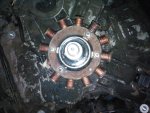ok, I won't have any time til this evening to pull it apart, but yes the stator was disconnected when I checked resistance, and the motor was cold, had not been run at all. however I didn't try putting a incandescent light bulb on it to try. and I'm not sure if I know what you're talking about with the reluctor wheel and gear, but I will pull the flywheel and inspect and try to find this.
Don't worry about the test light on the stator - if the motor hasn't been running recently it's nothing to concern yourself with. At best a static charge will hold for 30-40 seconds after shutdown.
Regarding the reluctor wheel: according to the manual Rivets linked you to, the flywheel doubles as the reluctor wheel (see page 7-10, it's referred to as the "Alternator Rotor"). What you want to do is remove the flywheel and inspect the side of it that doesn't face up/out when it's installed. If it's a cupped/concave flywheel, you want to look at the concave side. You should see 1 of the 3 following configurations (the pictures in the manual aren't very good otherwise I might be able to tell you exactly what to look for):
1) There will be internal-facing teeth on the outer rim of the flywheel (most likely set up), or
2) There will be external-facing teeth around the center bore of the flywheel.
3) There's a magnet(s) mounted on the flywheel.
Regardless of whether it's magnets or teeth (or a combination of both), the principle is the same - as they pass by the coils of wire on the stator, voltage is generated within the coil which is then fed to the regulator. If there are any defects in the stator or the teeth (or magnets), it will not work as efficiently. All you need to look for are obvious defects that would cause the faulty operation - cracks, broken, chipped or missing teeth (or magnets).

